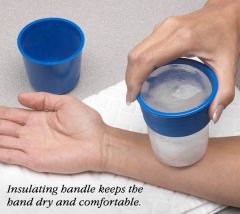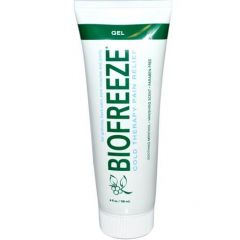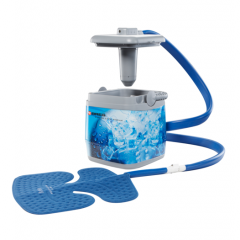![]()
![]()
![]()
Use LEFT and RIGHT arrow keys to navigate between flashcards;
Use UP and DOWN arrow keys to flip the card;
H to show hint;
A reads text to speech;
76 Cards in this Set
- Front
- Back
|
Spinoparabrachial Tract consists of:
|
the affective component of pain
|
|
|
Spinoreticular Tract consists of:
|
1. Modulation of pain
2. Motivational, emotional, unpleasant component of pain |
|
|
Spinohypothalamic-Limbic Tract consists of:
|
Autonomic adjustments to pain
|
|
|
Anterolateral Systems "Take Home" message is that is has:
|
1. Multiple ascending pathways
2. Ipsilateral, contralateral, bilateral 3. Redundant system |
|
|
Names the Different States of pain:
|
1. Acute Pain
2. Referred Pain 3. Persistent Pain |
|
|
Acute Pain is:
|
Sharp
Localized Rapid onset Short duration (usually) Warning of tissue damage (actual or potential) **A Delta is most responsible for this** |
|
|
Referred Pain is:
|
Pain at a site remote from the source of pathology & occurs due to convergence
Brain unable to decipher or determine where pain is coming from Ex. Heart Attack |
|
|
Persistent Pain is:
|
Pain that is recurrent or episodic
May accompany a re-injury or associated chronic condition Ex. Someone with poor posture can cause neck pain (It comes and goes) |
|
|
You can assess pain by:
|
1. Numerical
2. Verbal rating scale 3. Visual analog scale |
|
|
Assessment Scales should include:
|
Severity
Location Quality Observation of non verbal cues Mode, duration of onset Provocating and relieving factors **look for non-verbal cues |
|
|
Numerical Pain Scale Is:
|
Give pt 0 to 10
Qualify numbers What is zero, what is ten |
|
|
Verbal Rating Scale is:
|
No pain, mild, moderate, etc.
|
|
|
Visual Analog Scale is:
|
Number line, or Faces for Kids!
|
|
|
Abnormal Pain can be:
|
1. Allodynia
2. Hyperalgesia 3. Neuropathic 4. Chronic Pain |
|
|
Parallel Ascending Pathways of Pain are from
|
spinal cord to higher centers
|
|
|
Parallel Ascending Pathways of Pain have Multiple Pathways and they are what?
|
Spinothalamic Tract, Spinomesencephalic tract, Spinoparabrachial tract, Spinoreticular tract, Spinohyphothalamic-limbic tract
|
|
|
Parallel Ascending Pathways of Pain are also known as:
|
Anterolateral System
|
|
|
Spinothalamic Tract has what actions involving in it:
|
Discrimitive pain
Temperature Crude touch Pressure |
|
|
Spinomesencephalic Track has:
|
Pain modulation
Sensorimotor integration of pain Motor reflex to pain |
|
|
What does Ipsilateral, Contralateral, and Bilateral mean:
|
Ipsilateral-SAME SIDE
Contralateral-OPPOSITE Bilateral- Both side at the same time!!! |
|
|
Pain States Consist of:
|
Pain sensation increases when painful stimulus persists
This can lead to pathologic pain states, where pain persists without the initial trauma. |
|
|
How many points on a Scale can you move up and down to see a difference in someone pain level?
|
If pain decreases by 2, you are making a difference in their pain for the better
Increase by 2 (makes it worse), It is important to access it each visit when you see them |
|
|
Cold Modalities are:
|
One of the most effective and least expensive modes of acute injury and pain management
|
|
|
What 3 things does cryotherapy cause the body to do?
|
Decreased swelling, vasoconstriction,
Decrease muscle spasm so should have more ROM Decrease pain |
|
|
In Cryotherapy, you want to _______ blood flow and metabolism __________ bleeding and inflammation (acute swelling)
Increase/Decrease? |
Decrease; Decreased
|
|
|
In Cryotherapy, you want to ________ in muscle spasm allows for _________ pain free ROM
Increase/Decrease? |
Decrease; Increase
|
|
|
Does pain threshold increase or decrease?
|
Increase
|
|
|
Conduction is:
|
transfer of energy through direct contact
|
|
|
Convection is:
|
what would occur if you had them in a cold whirlpool
In something moving around; Gravity depended position will cause more swelling |
|
|
Evaporation is:
|
sweat
The cooler substance pulls the heat out, then evaporates off the skin. **Cooler substance cooling it off like Cooling spray |
|
|
In Cryotherapy, cooling is accomplished by:
|
removing heat from an object
**Actually removing the heat not adding cold |
|
|
Thermal conductivity is the:
|
Efficiency of a material or tissue to conduct heat
**Metals more efficient than non-metals |
|
|
Conduction transfer of heat by:
|
Direct interaction of the molecules in the warmer area with those in the cooler area
Ex. Ice packs, cold water immersion, ice water filled cuffs |
|
|
Tissues with higher water content have better thermal conductivity like:
|
Muscles better than adipose tissue
Adipose (fat) tissue serves as an insulator and resists heat transfer (gains or losses) Muscles generally sit under adipose tissue |
|
|
With application of cold therapies the patients will experience 4 different stages, what are they?
|
1. Cold
2. Burn 3. Ache 4. Numbness Ex. Ice Massage **Make sure you explain to your patients what is going to happen!! |
|
|
Factors Influencing Cold Therapy Response are:
|
1. Temperature difference between cold object and soft tissue
2. Time of exposure 3. Thermal conductivity 4. Type and size of cooling agent 5. Body surface to be covered 6. Activity level 7. Ability of cooling agent to maintain its temperature |
|
|
Arterial blood is warmer than venous and with _______ blood flow you get ________ arterial blood
Increase/Decrease? |
Decrease; Decreased
|
|
|
The energy transfer between arteries and veins increase/decrease?
|
Decrease
**Arteries and veins are close to each other |
|
|
Convection is:
|
Direct connection between skin and moving fluid
Rarely used because machines are expensive, bulky, big Ex. Cold whirlpool, Specific heat of water |
|
|
Convection is not encouraged in the Acute Phase of Healing, Why?
|
Because you DO NOT want to put heat on an ankle sprain right away, puts the extremity in a dependent position- increase EDEMA!!!
|
|
|
Heat loss in Convection is:
|
25 x greater in water versus air
**Heat abstraction occurs a lot faster than cold |
|
|
Vapocoolant Spray is:
|
1. Used for pain relief for trigger points before stretch
**Volatile liquids, Evaporates immediately, Upon contact with skin it extracts heat |
|
|
Vapocoolant is applied in:
|
sweeping strokes
**Temp can drop by 15 degrees C |
|
|
Hemodynamic Effects of Cold Agents are:
|
1. Immediate response is vasoconstriction of cutaneous blood vessels
2. Vessel diameter most significant factor relating to blood flow 3. Exposure to cold therapy for 15 minutes or less 4. Vasoconstriction of arterioles and venules 5. Posttraumatic Edema and Inflammation 6. First 24-72 hours cold is usually the modality of choice |
|
|
Peripheral Nerve Effects are:
|
1. Cold alters conduction velocities
2. May also cause failure to conduct impulses **Cooling to 56° F blocked conduction of A fibers, Lower than 56 to block C fibers Some cases of neurapraxia and axonotmesis |
|
|
Neuropraxia is:
|
Failure of nerve conduction blocked without structural damage – 1hr of ice
Temporary condition, effects usually reversed in 6-8 weeks Least serious |
|
|
Axonotmesis is:
|
discontinuity of axons, but endo, peri,
|
|
|
Epineurium Intact you should:
|
Ice for 2hrs
More severe than neuropraxia Long lasting & more dangerous Irreversible |
|
|
What are the effects of Cryotherapy on the muscle?
|
1. Debate is whether to ice before or after
2. Increase in strength after 5 minutes of ice massage 3. Decrease in strength after 30 minutes of immersion in 10 to 12 degrees C (Possibly due to decreased muscle blood flow, Strength then increased) |
|
|
Neuromuscular Effects can:
|
help reduce spasticity
**Seen with increased DTR and with clonus; Effects temporary |
|
|
Primary Goals of Cryotherapy are to:
|
Limit edema
Reduce pain Muscle relaxation/ contraction Limit secondary hypoxic tissue injury |
|
|
What does RICE or PRICE mean?
|
Protection
Rest Ice Compression Elevation |
|
|
Cryokinetics, you should:
|
should be apply cold for a maximum of twenty minutes to numb the area
Process can be repeated for 5 minutes to 're-numb' the area if necessary Exercises performed during cryokinetics are active & should be gradually increased in intensity providing they remain pain free |
|
|
Myofascial Pain is:
|
referred from active myofascial trigger points with associated dysfunction
Trigger points present in skin, ligaments, and fascia May be related to muscle strain Trigger points found via digital pressure Ex. Stretch & spray, ice massage, deep pressure |
|
|
In Cryotherapy, Spasticity goal is to:
|
1. Decrease tone to allow for increased movement
2. Cold applied over the hypertonic muscle for 10 to 30 minutes 3. Various methods used 4. Effects last approx 1 to 1.5 hrs |
|
|
You want to use cold for how long for spasticity:
|
10-30 minutes
**Low load, long duration stretch is best for spasticity; Don’t want to excite the muscle spindle |
|
|
Guidelines for Use, you need to be:
|
1. Familiar w/ medical history & status like Contraindications
2. Time post injury 3. Consider safety Ex. Try small region first; Avoid potential stresses of tissue for approximately 2 hours |
|
|
Cold Packs are? and How do you use them?
|
Inexpensively purchased or easily made
Uses: 1. For hygiene, use layer of towel 2. Be careful with chemical ice packs (packs that must be popped), as the chemicals can burn skin if exposed. 3. Gel packs typically stay cool for 15 to 20 minutes |
|
|
Ice Massage is?
|

Typically done over small region
Ex. Muscle belly, tendon, bursa, trigger points |
|
|
How do you do Ice Massage:
|
1. Freeze water in paper or foam cup or use commercially available ice massage cups
2. A 10 by 15 cm region may be covered in 5 to 10 minutes 3. Use small overlapping circles |
|
|
During Ice Massage there are 4 sensations that should happen (Intense Cold, Burning, Aching, Numbness CBAN) and the Burning and Aching should pass in approx., how many minutes?
|
1-2 minutes
|
|
|
Cold Baths are:
|
Used to cool distal extremities
Water temps range from 13 to 18 degrees C Lower temps correlate with shorter immersion times Basin of cold water and ice is sufficient |
|
|
Vapocoolant Spray you want to:
|

1. Position patient to facilitate relaxation
2. Muscle is put on passive stretch 3. Spray in unidirectional motion 4. Over trigger point 5. Over referred pain regions |
|
|
Cold Gels are:
|

Creams that give perceived sensation of cold
Easy to apply Very portable No need for refrigeration Ex. BioFreeze |
|
|
Polar Packs/Game Ready are for:
|

Acute musculoskeletal injuries
Status post surgery Range from 10 to 25 deg C Intermittently inflated to push edema out of region |
|
|
Contraindications for Cryotherapy are:
|
Uticaria
Cold Intolerance Cryoglobulinemia Raynaud’s Disease Over a regenerating peripheral nerve Over an area of circulatory compromise Over an area of peripheral vascular disease |
|
|
Uticaria:
|
pt. has allergic reaction to cold (hives)
|
|
|
Cold Tolerance:
|
pt. doesn’t like the cold
|
|
|
Cryoglobulinemia is:
|
abnormal blood protein forms gels when exposed to cold. Can lead to ischemia or gangrene
**Patient should know this prior to therapy |
|
|
Raynaud's Disease is:
|
Vasospastic disorder, cooler than 60 degrees. Shunting blood away
**Over a regenerating peripheral nerve – you want it to regenerate |
|
|
Precautions for Cryotherapy are:
|
Hypertension
Over a superficial peripheral nerve (danger of neuropraxia) Over an open wound Poor sensation (can't feel how bad it can hurt) Poor cognition (doesn't understand you) Very young or very old (typically like heat) Aversion to cold (doesn't care for cold) |
|
|
How do you know Cryotherapy is working?
|
ROM increased
Decrease swelling Perceived pain (how well it feels) Girth measurement |
|
|
What are the Parameters you need to document when giving cryotherapy?
|
Type of agent
Time on it Location Position Temp Use anything to help compress it Skin color after How they are seating/laying |
|
|
You should always be aware of the changes in the patients response by:
|
1. Beneficial or adverse
2. Skin color |
|
|
Case Study # 1
A 17 year old male is referred with a diagnosis of acute grade II right lateral ankle sprain that occurred 12 hours prior. After the examination he demonstrated notable effusion throughout the right ankle, (lateral>medial) decreased AROM, and pain that increases with AROM or PROM and while WB. 1. Does the pt. have a dysfunction, limitation, or problem that can be improved with the use of cryotherapy? 2. What type of cryotherapy could be used and what specific parameters are appropriate? |
1.Yes, pain can be reduced allowing more ROM, resistive exercise and increase WB to complete normal gait cycle, swelling can be reduced.
2. Until numbness to the area is felt, icepack, ice bath, |
|
|
Case Study #2
|
Look at in the Powerpoint (last slide in Cryotherapy)
|

